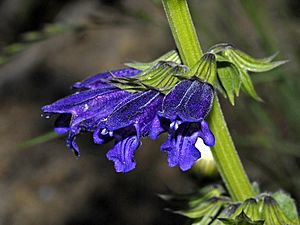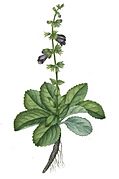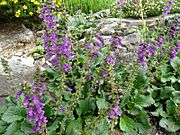Dragonmouth facts for kids
Quick facts for kids Dragonmouth |
|
|---|---|
 |
|
| Flowers of Horminum pyrenaicum at the Giardino Botanico Alpino Chanousia | |
| Scientific classification | |
| Genus: |
Horminum
|
| Species: |
pyrenaicum
|
Horminum is a genus of flowering plants that belongs to the Lamiaceae family, also known as the mint family. There is only one species in this genus, called Horminum pyrenaicum. People sometimes call it dragonmouth or Pyrenean dead-nettle.
What it Looks Like
Horminum pyrenaicum is a plant that lives for many years, growing up to about 45 centimeters (18 inches) tall. Its stems are square and have tiny hairs.
The leaves grow in a circle at the bottom of the plant, like a rosette. They are usually 3–7 cm long and 2–5 cm wide. These leaves are shiny, dark green, and have a bumpy, quilted look with slightly toothed edges.
The flowers grow in groups along the upper parts of the stems. They are a beautiful violet-blue or dark purple color. Each flower is shaped like a tube or a bell, about 1.5–2 cm long, and has two "lips." You can usually see these flowers blooming from July to August.
Where it Grows
This special plant is found naturally in the Pyrenees and Alps mountain ranges. These mountains are located in western Europe.
Horminum pyrenaicum likes to grow on rocky slopes, in pastures, and in grassy areas. It prefers high places, usually between 1,400 and 2,500 meters (about 4,600 to 8,200 feet) above sea level.
How to Grow This Plant
If you want to grow Horminum pyrenaicum, it needs certain conditions to thrive. It grows best in soil that is rich in peat and drains water well, but it shouldn't be too rich in nutrients. This plant loves full sun.
Since it's an alpine plant, it prefers places with mild summers and cool nights. Make sure the soil stays evenly moist, but not soaking wet. You can feed it once at the start of its growing season with a slow-release fertilizer.
You can grow new plants from seeds. Plant the seeds in the autumn and let them experience the cold temperatures of winter. Another way to get more plants is by dividing older, established clumps in the spring.
Gallery
See also
 In Spanish: Horminum para niños
In Spanish: Horminum para niños




